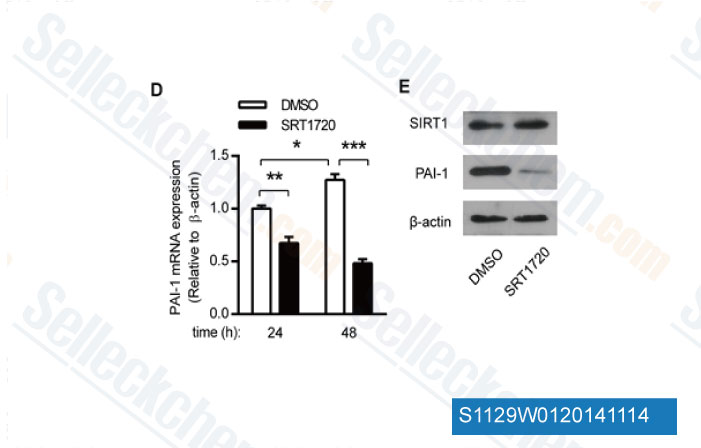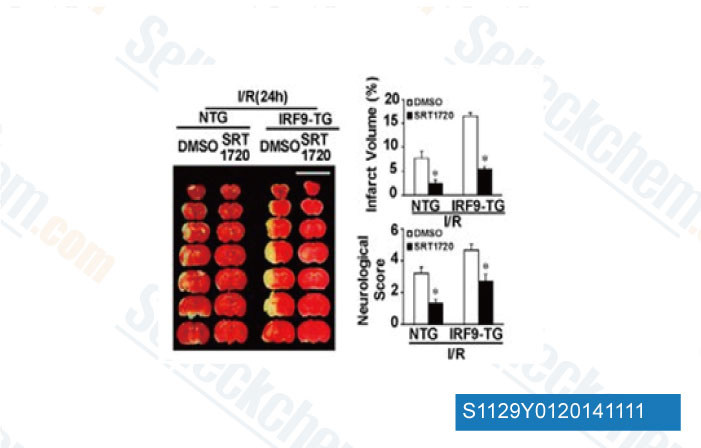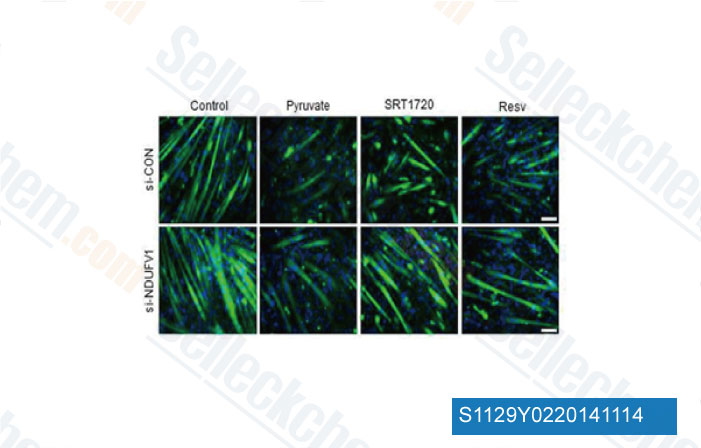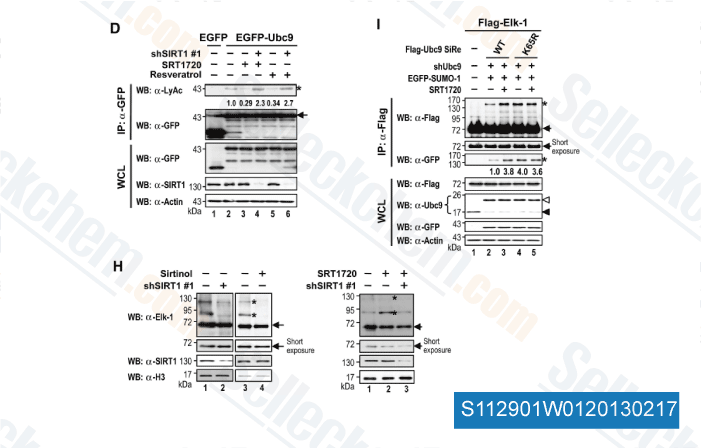|
Toll Free: (877) 796-6397 -- USA and Canada only -- |
Fax: +1-832-582-8590 Orders: +1-832-582-8158 |
Tech Support: +1-832-582-8158 Ext:3 Please provide your Order Number in the email. |
Technical Data
| Formula | C25H23N7OS.HCl |
||||||
| Molecular Weight | 506.02 | CAS No. | 1001645-58-4 | ||||
| Solubility (25°C)* | In vitro | DMSO | 100 mg/mL (197.62 mM) | ||||
| Water | Insoluble | ||||||
| Ethanol | Insoluble | ||||||
| In vivo (Add solvents to the product individually and in order) |
|
||||||
|
* <1 mg/ml means slightly soluble or insoluble. * Please note that Selleck tests the solubility of all compounds in-house, and the actual solubility may differ slightly from published values. This is normal and is due to slight batch-to-batch variations. * Room temperature shipping (Stability testing shows this product can be shipped without any cooling measures.) |
|||||||
Preparing Stock Solutions
Biological Activity
| Description | SRT1720 HCl is a selective SIRT1 activator with EC50 of 0.16 μM in a cell-free assay, but is >230-fold less potent for SIRT2 and SIRT3. SRT1720 induces autophagy. | ||
|---|---|---|---|
| Targets |
|
||
| In vitro | The maximum activation ratio of SRT1720 versus the closest sirtuin homologues, SIRT2 (EC1.5 = 37 μM) and SIRT3 (EC1.5 > 300 μM) is up to 781%. SRT1720 binds to the SIRT1 enzyme-peptide substrate complex at an allosteric site amino-terminal to the catalytic domain and lower the Michaelis constant for acetylated substrates. SRT1720 could reduce fed glucose levels. SRT1720 does not have an effect on fasting glucose in chow-fed mice, revealing that pharmacological SIRT1 activation is unlikely to induce hypoglycaemia. SRT1720 significantly reduces the hyperinsulinaemia after 4 weeks, partially normalizing increased insulin levels. SRT1720 treatment increases mitochondrial capacity by 15% in gastrocnemius muscle as measured by citrate synthase activity. [1] Higher concentrations of SRT1720 (15 μM) induces a modest (10-20%) decrease in normal cell viability. SRT1720 also significantly inhibits VEGF-dependent MM cell migration. [2] |
||
| In vivo | In DIO mice SRT1720 mimics several of the effects observed after calorie restriction including improved insulin sensitivity, normalized glucose and insulin levels, and increased mitochondrial capacity. In addition, in diet-induced obese and genetically obese mice, SRT1720 improves insulin sensitivity, lower plasma glucose, and increase mitochondrial capacity. Thus, SRT1720 is a promising new therapeutic agent for treating diseases of ageing such as type 2 diabetes. Consistent with improved glucose tolerance, the glucose infusion rate required to maintain euglycaemia is approximately 35% higher in SRT1720-treated fa/fa rats, and the total glucose disposal rate is increased by approximately 20%. [1] SRT1720 also prevents multiple myeloma tumor growth. |
Protocol (from reference)
| Kinase Assay: |
|
|---|---|
| Cell Assay: |
|
| Animal Study: |
|
References
|
Customer Product Validation

-
Data from [Data independently produced by Aging Cell, 2014, 13(5), 890-9]

-
Data from [Data independently produced by J Neurosci, 2014, 34(36), 11897-912]

-
Data from [Data independently produced by J Biol Chem, 2014, 289(29), 20012-25]

-
Data from [EMBO J, 2013, 32, 791-804]
Selleck's SRT1720 HCl has been cited by 188 publications
| Inhibition SIRT1 to regulate FOXP3 or RORγt can restore the balance of Treg/Th17 axis in ulcerative colitis and enhance the anti-inflammatory effect of moxibustion [ Front Immunol, 2024, 15:1525469] | PubMed: 39867884 |
| SIRT1 Regulates Mitochondrial Damage in N2a Cells Treated with the Prion Protein Fragment 106-126 via PGC-1α-TFAM-Mediated Mitochondrial Biogenesis [ Int J Mol Sci, 2024, 25(17)9707] | PubMed: 39273653 |
| TNF-α-downregulated SIRT1 regulates mitochondrial-autophagy and apoptosis in renal vascular endothelial cells involved in trichloroethylene-induced immune kidney injury [ Int Immunopharmacol, 2024, 143(Pt 2):113521] | PubMed: 39476564 |
| Protectin D1 ameliorates non-compressive lumbar disc herniation through SIRT1-mediated CGRP signaling [ Mol Pain, 2024, 20:17448069241232349] | PubMed: 38288478 |
| The silent information regulator 1 agonist SRT1720 reduces experimental intracerebral hemorrhagic brain injury by regulating the blood-brain barrier integrity [ Neuroreport, 2024, 35(11):679-686] | PubMed: 38874950 |
| SIRT1 mediates the antagonism of Wnt/β-catenin pathway by vitamin D in colon carcinoma cells. [ bioRxiv, 2024, 10.1101/2024.01.21.576539] | PubMed: none |
| SRT1720, an activator of silent information regulator 1, alleviates acute traumatic brain injury in a rat model [ Chinese Journal of Tissue Engineering Research, 2024, (28): 4447-4454.] | PubMed: none |
| Vascular Electrical Stimulation with Wireless, Battery-Free, and Fully Implantable Features Reduces Atherosclerotic Plaque Formation Through Sirt1-Mediated Autophagy [ Small, 2023, e2300584.] | PubMed: 37267941 |
| SIRT1 attenuates blood-spinal cord barrier disruption after spinal cord injury by deacetylating p66Shc [ Redox Biol, 2023, 60:102615] | PubMed: 36716673 |
| SIRT1 attenuates blood-spinal cord barrier disruption after spinal cord injury by deacetylating p66Shc [ Redox Biol, 2023, 60:102615] | PubMed: 36716673 |
RETURN POLICY
Selleck Chemical’s Unconditional Return Policy ensures a smooth online shopping experience for our customers. If you are in any way unsatisfied with your purchase, you may return any item(s) within 7 days of receiving it. In the event of product quality issues, either protocol related or product related problems, you may return any item(s) within 365 days from the original purchase date. Please follow the instructions below when returning products.
SHIPPING AND STORAGE
Selleck products are transported at room temperature. If you receive the product at room temperature, please rest assured, the Selleck Quality Inspection Department has conducted experiments to verify that the normal temperature placement of one month will not affect the biological activity of powder products. After collecting, please store the product according to the requirements described in the datasheet. Most Selleck products are stable under the recommended conditions.
NOT FOR HUMAN, VETERINARY DIAGNOSTIC OR THERAPEUTIC USE.
